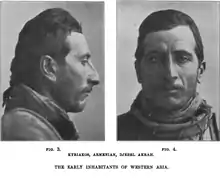Armenoid race
In the discredited racial anthropology of the early 20th century, the Armenoid type was a subtype of the Caucasian race.[1] According to anthropologist Carleton Coon, the countries of the northern part of Western Asia, namely Anatolia, the Caucasus, Iraq, Iran, and the Levant, were considered the center of distribution of the Armenoid race.

History of term
The term was used by Austrian anthropologist Felix von Luschan and Eugen Petersen in the 1889 book Reisen in Lykien, Milyas und Kibyratis ("Travel in Lycia, Milyas and Kibyratis").[2][3]
Prominent Nazi and racial theorist Hans F. K. Günther used the term 'Near Eastern race' to describe the Armenoid type, and ascribed Near Eastern characteristics to several contemporary peoples, including: Armenians, Jews, Greeks, Georgians, Iranians, Assyrians, Syrians, and Turks.[4] Günther regarded Jews as people of multiple racial origins but defined the Near Eastern race as their major basis, and described the race's characteristics such as its "commercial spirit" and as being "artful traders" who had strong psychological manipulation capacities that helped their trade, as well as being known to exploit people.[4] Günther's conception has been criticized for pseudoscientific analysis.[4] Nazis historically identified Jews as within the Armenoid type in the name of the Near Eastern race.[5]
The Nazis never fully clarified their racial doctrine, and Günther' s work was never canonised or entirely accepted even by the SS, which switching freely between race definitions.[6][7]
Physiognomy

Carleton S. Coon wrote that the Armenoid racial type is very similar to the Dinaric race, most probably due to racial mixture with the Mediterraneans (who often have olive skin) and the Alpines (who often have pale skin). The only difference is that Armenoids have a slightly darker pigmentation. He described the Armenoid as a sub-race of the Caucasoid race. Armenoids were said to be found throughout Eurasia. However, the largest concentrations occurred within Armenia, Transcaucasia, Iran, and Mesopotamia.
Armenoids were medium to tall, average height being 167 cm, usually with dark brown or black hair, wavy to curly in form,[8] tawny white to light-brown skin color, large round eyes that were usually dark brown, a round, brachycephalic head shape with a straight backing (planocciput) (see Cephalic index), high cheekbones and medium chin prominence, thick eyebrows, abundant hair on body and face, and a prominent, often aquiline nose.[8] Armenians were as a rule thin-lipped, with medium chin prominence, a palpable bilateral cleft in the chin, and flaring gonial angles. This racial type was believed to be prevalent among some Armenians, Assyrians, and northern and central Iraqis.[9][10]
Distribution
The Armenoid race type was claimed to exist to the west and north of the Arabid race, and encompasses Armenians, Georgians, Assyrians, Jews, Syrians, Maronites, Druze, Greeks, Turks, Kurds, Iranians, Arab Israelis, Yazidis, among other peoples of the Middle East region.[11] It was found in ancient Sumerians, Babylonians, Hittites, and Cypriots.
It has long been believed by physical anthropologists that the quintessence of Near Eastern brachycephaly is to be found in the Armenians; the racial term Armenoid being named for them. The Armenians have long been established in the territory which is now only partly theirs; they had, before the arrival of the Turks, a powerful kingdom, which covered most of the territory between the Gulf of Alexandretta and the Caucasus.[12]
See also
References
- Ripley, William Z. (1899). The Races of Europe: A Sociological Study. D. Appleton & Company. p. 444.
- Luschan, Felix Von (1911). "The Early Inhabitants of Western Asia". The Journal of the Royal Anthropological Institute of Great Britain and Ireland. Royal Anthropological Institute of Great Britain and Ireland. 41: 242. doi:10.2307/2843172. hdl:2027/uc2.ark:/13960/t4nk3d322. JSTOR 2843172.
When I first upheld in 1892, in my paper on the anthropological position of the Jews, the homogeneous character of these groups, I called them "Armenoids." But there can be no doubt that they are all descended from tribes belonging to the great Hittite Empire
- Petersen, Eugen; Luschan, Felix von. Lykien, Milyas und Kibyratis (1889).
- Alan E Steinweis. Studying the Jew: Scholarly Antisemitism in Nazi Germany. Harvard University Press, 2008. P. 29.
- Mitchell B. Hart. Jews & Race: Writings on Identity & Difference, 1880-1940. Lebanon, New Hampshire, USA: Brandeis University Press, 2011. P. 247.
- McMahon, Richard Eoin (2007). The Races of Europe: Anthropological Race : Classification of Europeans 1839-1939 (Thesis). EUI PhD theses; Department of History and Civilization. European University Institute. p. 270. doi:10.2870/79569.
- Lutzhöft(1971), 21-22
- Sharma, Ramnath; Sharma, Rajendra K. (1997). Anthropology. Atlantic. p. 108. ISBN 978-8171566730.
- Fisher, William B. (2003). The Middle East and North Africa, Volume 50. Routledge. p. 444. ISBN 978-1-85743-184-1.
The northern and eastern hill districts [of Iraq] contain many racial elements—Turkish, Persian, and proto-Nordic, with Armenoid strains predominating. […] the population of the riverine districts of Iraq displays a mixture of Armenoid and Mediterranean elements. North of the Baghdad district the Armenoid strain is dominant.
- Fisher, William B. (1966). The Middle East: A Physical, Social and Regional Geography. Methuen. p. 96. ISBN 978-0-416-71510-1.
Armenoid affinities are easily discerned in the peoples of northern and central Iraq.
, extract of page 444 - Review: An Introduction to the Anthropology of the Near East by C. U. Ariëns Kappers, American Anthropologist, 37(35) - Pages 148-49 by W.M. Krogman
- The Races of Europe by Carleton Stevens Coon - (Chapter XII, section 18)